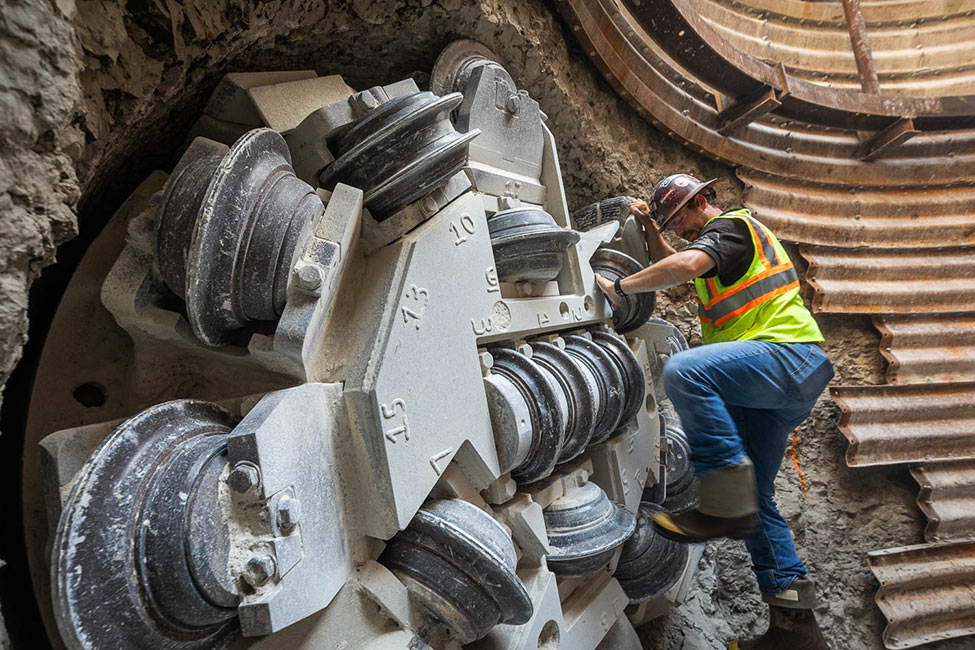Geology challenges interceptor bore 12 Sep 2019
Claiming to be the longest hard rock tunnel ever bored by a double shield TBM with a diameter of less than 2.5m (8.07ft), construction of the 3.5km (2.2 mile) Parmer Lane wastewater interceptor in Austin, Texas, USA, has been completed by contractor S J Louis Construction. The drive included two tight curves of 150m (500ft) radius and unexpected ground conditions that required modification of the cutterhead inside the tunnel. Maximum advance rate was 380m (1,250ft) per month, working in single 12 hour shifts per day.
The interceptor connects two existing lift stations at Lake Creek and Rattan Creek, allowing for these to be decommissioned and providing additional flow capacity by gravity, reducing operating costs for the City of Austin.
Despite expecting moderately hard limestone, with strengths ranging from 2,000 psi to 10,000 psi, and an occasional, thin seam of clay or soft material, the first 4,000LF was in a softer dolomite material saturated with clay. The remaining 8,000 LF was in the expected limestone formation. Since the rock was softer than expected, two double disc cutters were added by TBM manufacturer, Robbins, at positions 10 and 12, and the single disc cutter was removed at position 11. This added another transition cutter and helped with muck flow through the cutterhead (Fig 1). Robbins also assisted the crew while in the tight curves.
“While we excavated through the softer material, our best advance rate was close to 0.9m (3ft) per hour. When we bored through the expected limestone, advance rates were over 5.2m (17ft) per hour. Our best day was 25m (81ft) in a single shift,” said Zach West, Project Manager for S J Louis.
The length and smaller diameter of the alignment also posed a challenge. “The drive in a small tunnel with tight radius curves and limited surface access for over 2 miles was very difficult,” continued West. He added that the shallow depth and the alignment to within a few feet of sanitary lines, high-pressure gas mains, and fuel tanks for gas stations, made TBM guidance critical. “I am very proud of our ability to guide the machine successfully through these obstacles and into our retrieval shaft within our expected tolerances.”
Through one stretch, the TBM advanced directly between a 30cm (12in) diameter, high-pressure gas main and fuel tanks for a gas station with limited as-built information. “Navigating this section took a great deal of coordination with the local utility companies. Because the diameter was too small for an automated guidance system, we manually surveyed the front of the machine at every push to ensure the machine was on track,” said West.
The majority of the route used a simple two-rock-bolt pattern for support. In the last 10%, ribs and lagging were used as support. Final carrier pipe, which is now being installed, consists of 110cm (42in) diameter fiberglass pipe.
The project is part of a trend towards small diameter, TBM-driven rock tunnels in the USA. “Because of demographics and business growth, there is a growing need to increase sewer and water infrastructure. TBMs can excavate long distances with tight curves, reducing the need for multiple shafts, which lowers the overall project cost. As most small diameter pipelines follow a road or municipal right-of-way, traffic problems are reduced significantly compared with open cut operations,” said Tom Fuerst, Robbins Utility Tunneling Sales Manager.
References
- DigIndy over halfway on 45km route – TunnelTalk, August 2019
- Third breakthrough completes Texas water line – TunnelTalk, October 2013
- High-power TBMs jump start Texas water line – TunnelTalk, September 2012
|
|
|
|
|
Add your comment
- Thank you for taking the time to share your thoughts and comments. You share in the wider tunnelling community, so please keep your comments smart and civil. Don't attack other readers personally, and keep your language professional.





